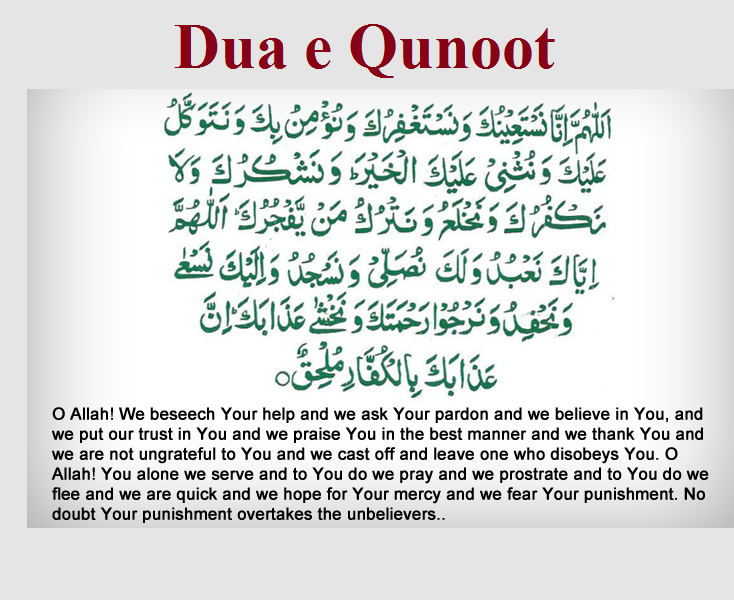
Qunnot in Witr – Abu Dawud said: This version of tradition is not well know. And he would say the Qunut before bowing, and when he finished he would say: Subhanal-Malikil-Quddus (Glory be to the Sovereign, the Most Holy) three times, elongating the words the last time. Sahih (Darussalam) Sunan an-Nasa’i 1699 In the first he would recite: “Glorify the Name of Your Lord, the Most High” in the second: “Say: O you disbelievers!”, and in the third: “Say: He is Allah, (the) One”. Qunoot in Witr during third rakat – It was narrated from Ubayy bin Ka’b that: The Messenger of Allah (ﷺ) used to pray witr with three rak’ahs. Qunoot in Subh Prayer and Maghrib – Al-Bara bin Azib narrated: “The Prophet (S) would perform the Qunut in the Subh and Maghrib prayers.” Sahih (Darussalam) Jami At-Tirmidhi 401 He was further asked, “Did he recite Qunut before bowing?” Anas replied, “He recited Qunut after bowing for some time (for one month).” Sahih al-Bukhari 1001 Qunoot in Fajr – Narrated Muhammad bin Seereen: Anas was asked, “Did the Prophet (ﷺ) recite Qunut in the Fajr prayer?” Anas replied in the affirmative. No, the dua e-qunoot is not mentioned in the Qur’an it is the Sunnah of the Prophet (ﷺ).


Can the Qunoot dua be found in the quran? It’s also acceptable the qunoot dua be done done before going into the ruku. After finishing the imam would say takbeer, “allahu akbar” and go into sujud. You would then raise your hands for supplication and recite the qunot. after saying sami allahu liman hamidah rabbana lakal hamd). Most scholars say the Qunoot should come after bowing or after the Ruku (i.e.
#Dua e qunoot in arabic text pdf how to#
This is Ruku Position – Image from our complete guide teaching Muslims how to preform salah. This was quoted by Ibn Muflih in his comment on al-Muharrar, 1/89 dua qunoot before or after ruku

He said: If one adds to that the words narrated from ‘Umar (may Allah be pleased with him), “Allahumma inna nasta‘eenuka… (O Allah, we seek Your help)…”, there is nothing wrong with that. He said: What is mustahabb in our view is that which was narrated by al-Hasan ibn ‘Ali from the Prophet (blessings and peace of Allah be upon him): “Allahumma ihdini…” – the well-known hadeeth. Ibn ‘Uqayl al-Hanbali (may Allah have mercy on him) narrated that dua’s narrated from the Prophet (ﷺ) should be what is recited as regular word, and anything added to it is by way of a concession. Surely, the disbelievers shall incur your torment. O Allah! We worship you and prostrate ourselves before you, and we hasten towards you and serve you, and we hope to receive your mercy and we dread your torment. Meaning: O Allah! We invoke you for help, and beg for forgiveness, and we believe in you and have trust in you and we praise you, in the best way we can and we thank you and we are not ungrateful to you, and we forsake and turn away from the one who disobeys you. Hanafi commonly recite second version of Dua-E-Qunot.


 0 kommentar(er)
0 kommentar(er)
